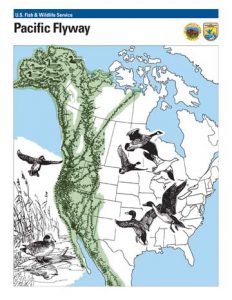Each year at least a billion birds migrate along the Pacific Flyway, which stretches from the North Slope of Alaska to Central and South America and includes the Palouse region. These birds depend on a diverse chain of habitats, from Arctic tundra and northwes

stern rainforest to tropical beaches and mangroves. Habitat loss, water shortages due to diversion for agriculture and development, diminishing food sources, and climate change all threaten the birds of the Pacific Flyway. Conservation efforts, especially on the highly erodible hills of the Palouse and steep breaks along the Snake River, can help address these concerns.
The Pacific Flyway is home to twenty-four priority bird species. Of these twenty-four, a number are found in the Palouse area at various times of the year including black-necked stilt, long-billed curlew, northern goshawk, sandhill crane, spruce grouse, Swainson’s hawk, tri-colored blackbird, varied thrush, and Western sandpiper. These birds warrant special attention for local conservation and habitat improvement efforts.
Palouse Audubon has been active on several fronts to restore and improve wildlife habitat. The most recent examples are construction of nesting platforms for ferruginous hawks in western Whitman County and our work with the Women in Science group at the University of Idaho on the Stateline Wetlands project.
See our Citizen Science page to find out how you can become involved.